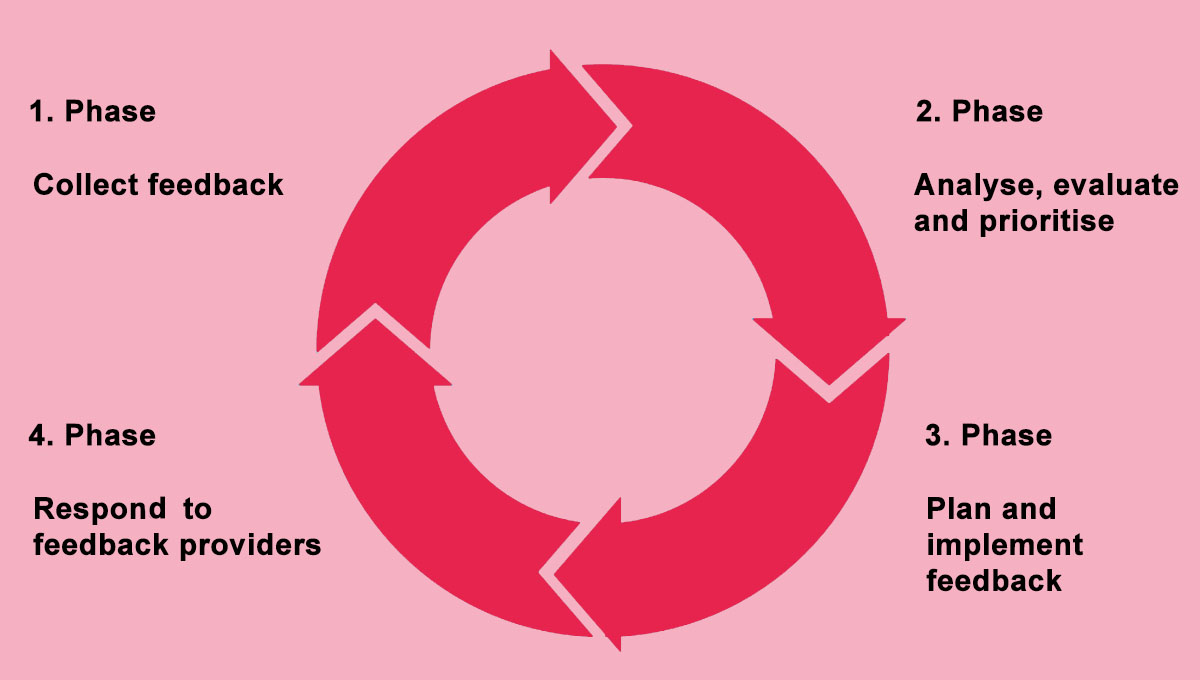Feedback in action: More than just words
How do you use feedback?
Do you use it to improve personal skills and abilities? Do you see it as part of a learning process? Does it help you make decisions? Does it help you avoid misunderstandings or conflicts?
Dealing with feedback is individual. Some people prefer to give it, others rather receive it. Some people see it as fuel for their personal development, others are reluctant and fear criticism or rejection. Some people are worried about hurting others with it, some people accept it only selectively. People are individual, so it is no surprise that the way they deal with feedback is not the same for everyone either.
And how does your company use feedback?
Customer feedback is an opportunity for companies
Feedback from customers or prospects is not always pleasant. Opinions and perspectives are not always nicely formulated or meant. Nevertheless – and this is probably not a world first – customer feedback is an opportunity for companies.
Of course, many companies have already recognised this opportunity and offer numerous options for leaving feedback:
- Customers receive emails after transactions asking for input.
- Visitors to a website can document their satisfaction in online forms.
- Users can find various rating options after using the app.
- Consumers are encouraged to fill rating platforms with their experiences and comments.
What these “queries” have in common is that they take place after an interaction – e.g. the use of a service or the purchase of a product. Another approach is to solicit opinions “before” a future interaction:
- Companies encourage potential or actual customers to participate ( paid or unpaid) in beta testing or product testing.
- Companies ask for feature requests that could be implemented in products or software solutions in the future.
- Companies create click dummies or wireframes to get perspectives on a solution to be developed.
- Companies use crowdsourcing, i.e. the contextual, punctual, temporary and targeted interaction with a large amount of people external to the company (crowd) to procure knowledge (sourcing).
Through feedback from customers, visitors, users or consumers, companies gain valuable perspectives that they can use to improve products and services. Sounds good in itself, doesn’t it? Unfortunately, there is often a “little something” missing in queries for interactions!
Employee feedback is also an opportunity for companies
Before I get into the ” little something”, let’s take a quick look at employees: Not only is customer feedback an opportunity for companies, so is input from employees.1
Numerous studies deal with the connection between employee satisfaction and job performance. It seems relatively clear that various factors such as the type of work, the corporate and leadership culture, clear tasks and expectations, good working conditions, economic success or individual personality influence employee satisfaction. Not surprisingly, companies therefore focus on measures to increase employee satisfaction. One means to this end can be to regularly collect feedback and also to express it honestly, appreciatively and fairly.
Regardless of the debate about whether customers or employees are more important for the success of a company2, it should be clear that feedback from employees can not only be used to improve internal aspects of a company, but also to increase the quality of products or services.
The feedback cycle. Or: The missing “little something”
Are you familiar with the feedback cycle (also known as the feedback circle or loop)?
It consists of four phases3 with the following contents4:
- collection of feedback
- analysis, evaluation and prioritisation of input
- planning and implementation of selected input
- respond to the feedback provider
Like so many phase models, the feedback cycle suggests a planned approach in which a subsequent phase begins after a previous phase ends. While this does not correspond to reality – companies nowadays continuously and automatically collect input after interactions – it is relatively easy to understand.
More important than this reality shift, in my view, is another point: communication between the parties takes place in phases 1 and 4. Once in the direction of the company, once in the opposite direction. Does your company communicate with clients and users about implementations that have been made as a result of concrete input (phase 4)? If yes: Congratulations!
I have the impression that many companies rarely practise phase 4. Often I even have the impression that phases 2 and 3 do not take place either, or at best only to a small extent. Why do I have this impression: Because companies neither communicate the phases nor the contents.
More than just words
I can only speculate about the reasons for the lack of communication. Perhaps some companies find it difficult to change their perspective in order to perceive the feedback cycle from the point of view of customers or interested parties. Perhaps companies are overwhelmed with the amount of opinions they automatically request, so that they leave the knowledge communicated therein unused. A company that is already sitting on a large mountain of requirements is not necessarily looking for additional input. And companies may not know how to communicate with input providers.5
Either way, though, one thing is clear to me: feedback must be followed by action. That may not always be easy in times of advancing automation, but it is a task that companies must solve. The very least is a “thank you”, in whatever form it is conveyed.
If a customer leaves an individual comment or provides an idea for a product improvement, then they definitely “deserve” an individual response.6
Responding to words with words is a good start. It shows a minimum of appreciation. An appreciation that customers and users already show by taking the time to leave opinions or describe experiences. They do this because they like or are interested in the brand, the manufacturer, the product or the service. Not responding to this as a company is negligent and could jeopardise the business relationship in the long run.
Better than a reaction in words is often a concrete action. A customer is dissatisfied with a service – what can you and your company do to increase her satisfaction? Why is she dissatisfied, what actions can remedy the situation? How can you make sure that future customers are not dissatisfied as well? Etc.7
Of course, feedback causes effort. If you want to avoid effort, you should probably refrain from collecting responses and opinions. For everyone else, feedback in action requires communication and sometimes more than just words. I am confident that the effort is worth it. Why? Because I enjoy communicating with companies that actively use my feedback. Because I like to recommend companies that value me. And even if people are individual, we are also similar in many ways, right?
Notes:
If you like the post or want to discuss it, feel free to share it in your network.
[1] 360-degree feedback is being addressed in many organisations. It is a format where a person receives feedback from superiors, employees, colleagues (and customers or partners).
[2] The customer is king – A discussion also about the importance of customers and employees.
[3] Obviously, the feedback cycle does not distinguish between internal and external input providers, i.e. not between customers or employees. Whose perspective deserves more weight in which situation, if any, could be the topic of another blog post.
[4] Some publications also speak of 5 phases; after the information to feedback providers or the follow-up with customers, phase 5 follows: collection of information.
[5] Perhaps my impression is deceiving and many companies are already integrating communication and feedback into their DNA.
[6] In the future, systems based on artificial intelligence will probably also provide valuable services in such a context.
[7] In such a situation, the 5-Whys Method can help. It is considered an instrument of root cause analysis, in which an issue is investigated by asking five times.
Michael Schenkel has published other articles in the t2informatik blog, including

Michael Schenkel
Head of Marketing, t2informatik GmbH
Michael Schenkel has a heart for marketing - so it is fitting that he is responsible for marketing at t2informatik. He likes to blog, likes a change of perspective and tries to offer useful information - e.g. here in the blog - at a time when there is a lot of talk about people's decreasing attention span. If you feel like it, arrange to meet him for a coffee and a piece of cake; he will certainly look forward to it!



